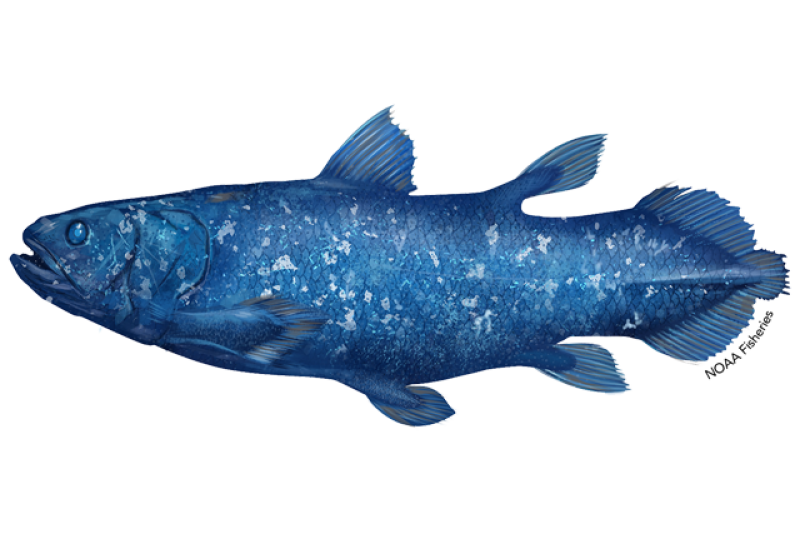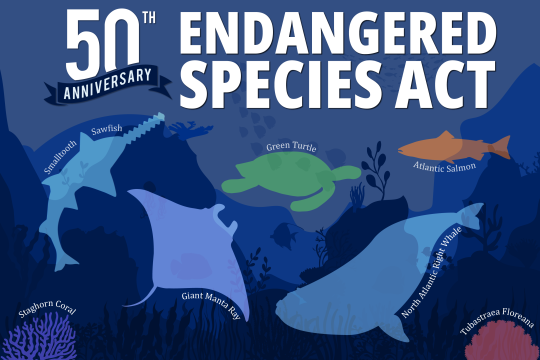African Coelacanth
Latimeria chalumnae

Protected Status
Quick Facts
About the Species
The African coelacanth belongs to an ancient lineage of bony, lobe-finned fish. The species was believed to have gone extinct over 65 million years ago but was rediscovered off the coast of South Africa in 1938. The Tanzanian distinct population segment (DPS) is thought to represent a single, isolated population of the species, having diverged approximately 200,000 years ago. The size of the population is likely small, with no connectivity to other populations. It also has late maturity and the longest generation time of any vertebrate. The main threats to the African coelacanth Tanzanian DPS include bycatch in shark gillnet fisheries and habitat destruction due to development. In 2016, NOAA Fisheries listed the DPS as threatened under the Endangered Species Act.
Appearance
The coelacanth has several unique physical features. Most notably are its paired lobe fins that extend away from the body and move in an alternating pattern. The body of the fish appears iridescent dark blue in film or video footage but under natural light the color is light brown with white blotches throughout that have been used for individual identification. They also have thick, armor-like scales and a unique joint at the back of the skull that allows them to open their upper and lower jaws at the same time.
Behavior and Diet
The coelacanth is a slow drift-hunter and eats a variety of benthic and epi-benthic prey, such as cephalopods, eels, cuttlefish, and deepwater fish.
Where They Live
The Tanzanian distinct population segment of African coelacanth lives among deep, rocky terraces comprised of sedimentary limestone between 230 to 460 feet in depth. In this habitat, coelacanths are thought to use submarine cavities and shelves for shelter. They are found in temperatures around 68° F.
 World map providing approximate representation of the African coelacanth's range.
World map providing approximate representation of the African coelacanth's range.
Lifespan & Reproduction
The average lifespan of coelacanths is estimated to be 48 years of age. Female coleacanths reach maturity between 16 and 19 years and give birth to live young after a very lengthy gestation period of 3 years, which is the longest gestation period of any vertebrate species.
Threats
Bycatch
Historically, fisheries bycatch has been the most significant threat to the coelacanth. The Tanzanian DPS in particular is subject to bycatch in the Tanzanian shark gillnet fishery, which has been expanding over the last decade.
Habitat Destruction
The Tanzanian DPS may experience direct habitat loss due to deep-water port construction, including submarine blasting and channel dredging known to occur in coelacanth habitat.
Scientific Classification
| Kingdom | Animalia | Phylum | Chordata | Class | Sarcopterygii | Order | Coelacanthiformes | Family | Latimeriidae | Genus | Latimeria | Species | chalumnae |
|---|
Last updated by NOAA Fisheries on 11/19/2024
Featured News

The Endangered Species Act: 50 Years of Conserving Species
Management Overview
The Tanzanian distinct population segment (DPS) of African coelacanth is listed as threatened under the Endangered Species Act.
Additionally, the African coelacanth is listed under:
- Appendix I of the Convention on International Trade in Endangered Species of Wild Fauna and Flora (CITES)
Regulatory History
In 2013, NOAA Fisheries received a petition to list the African coelacanth as threatened or endangered under the Endangered Species Act. In our 90-day finding, we concluded that the petitioned action may be warranted. After completing a status review, we proposed to list the Tanzanian DPS of the species as threatened and requested comments from the public. In 2016, NOAA Fisheries listed the Tanzanian DPS of African coelacanth as threatened under the Endangered Species Act.
Key Actions and Documents
More Information
Last updated by NOAA Fisheries on 11/19/2024
Documents
Endangered Species Act Status Review Report for the Coelacanth (Latimeria chalumnae)
This report is the status review for the African coelacanth, Latimeria chalumnae. This report…
Last updated by NOAA Fisheries on 11/19/2024